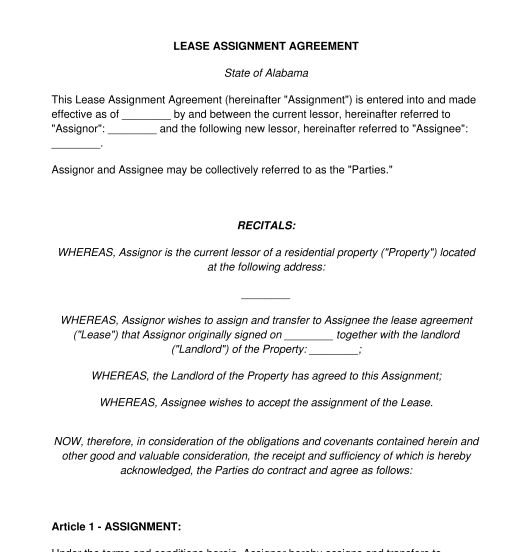

How does it work?
1. choose this template.
Start by clicking on "Fill out the template"
2. Complete the document
Answer a few questions and your document is created automatically.
3. Save - Print
Your document is ready! You will receive it in Word and PDF formats. You will be able to modify it.
Lease Assignment Agreement
Rating: 4.9 - 137 votes
A Lease Assignment Agreement is a short document that allows for the transfer of interest in a residential or commercial lease from one tenant to another. In other words, a Lease Assignment Agreement is used when the original tenant wants to get out of a lease and has someone lined up to take their place.
Within a Lease Assignment Agreement, there is not that much information included, except the basics: names and identifying information of the parties, assignment start date, name of landlord, etc. The reason these documents are not more robust is because the original lease is incorporated by reference , all the time. What this means is that all of the terms in the original lease are deemed to be included in the Lease Assignment Agreement.
A Lease Assignment Agreement is different than a Sublease Agreement because the entirety of the lease interest is being transferred in an assignment. With a sublease, the original tenant is still liable for everything, and the sublease may be made for less than the entire property interest. A Lease Assignment transfers the whole interest and puts the new tenant in place of the old one.
The one major thing to be aware of with a Lease Assignment Agreement is that in most situations, the lease will require a landlord's explicit consent for an assignment. The parties should, therefore, be sure the landlord agrees to an assignment before filling out this document.
How to use this document
This Lease Assignment Agreement will help set forth all the required facts and obligations for a valid lease assignment . This essentially means one party (called the Assignor ) will be transferring their rights and obligations as a tenant (including paying rent and living in the space) to another party (called the Assignee ).
In this document, basic information is listed , such as old and new tenant names, the landlord's name, the address of the property, the dates of the lease, and the date of the assignment.
Information about whether or not the Assignor will still be liable in case the Assignee doesn't fulfill the required obligations is also included.
Applicable law
Lease Agreements in the United States are generally subject to the laws of the individual state and therefore, so are Lease Assignment Agreements.
The Environmental Protection Agency governs the disclosure of lead-based paint warnings in all rentals in the States. If a lead-based paint disclosure has not been included in the lease, it must be included in the assignment. Distinct from that, however, required disclosures and lease terms will be based on the laws of the state, and sometimes county, where the property is located.
How to modify the template
You fill out a form. The document is created before your eyes as you respond to the questions.
At the end, you receive it in Word and PDF formats. You can modify it and reuse it.
A guide to help you: Tenants and Subtenants Obligations under a Sublease Agreement
Other names for the document:
Assignment Agreement for Commercial Lease, Assignment of Commercial Lease, Assignment of Lease, Assignment of Residential Lease, Assignment Agreement for Lease
Country: United States
Housing and Real Estate - Other downloadable templates of legal documents
- Security Deposit Return Letter
- Rent Payment Plan Letter
- Residential Lease Agreement
- Sublease Agreement
- Tenant Maintenance Request Letter
- Rent Receipt
- Late Rent Notice
- Notice of Intent to Vacate
- Roommate Agreement
- Quitclaim Deed
- Parking Space Lease Agreement
- Short-Term Lease Agreement
- Tenant Security Deposit Return Request
- Termination of Tenancy Letter
- Change of Rent Notice
- Complaint Letter to Landlord
- Lease Amendment Agreement
- Notice of Lease Violation
- Consent to Sublease
- Eviction Notice
- Other downloadable templates of legal documents

Assignment of Lease
Jump to Section
What is an assignment of lease.
The assignment of lease is a title document that transfers all rights possessed by a lessee or tenant to a property to another party. The assignee takes the assignor’s place in the landlord-tenant relationship.
You can view an example of a lease assignment here .
How Lease Assignment Works
In cases where a tenant wants to or needs to get out of their lease before it expires, lease assignment provides a legal option to assign or transfer rights of the lease to someone else. For instance, if in a commercial lease a business leases a place for 12 months but the business moves or shuts down after 10 months, the person can transfer the lease to someone else through an assignment of the lease. In this case, they will not have to pay rent for the last two months as the new assigned tenant will be responsible for that.
However, before the original tenant can be released of any responsibilities associated with the lease, other requirements need to be satisfied. The landlord needs to consent to the lease transfer through a “License to Assign” document. It is crucial to complete this document before moving on to the assignment of lease as the landlord may refuse to approve the assignment.
Difference Between Assignment of Lease and Subletting
A transfer of the remaining interest in a lease, also known as assignment, is possible when implied rights to assign exist. Some leases do not allow assignment or sharing of possessions or property under a lease. An assignment ensures the complete transfer of the rights to the property from one tenant to another.
The assignor is no longer responsible for rent or utilities and other costs that they might have had under the lease. Here, the assignee becomes the tenant and takes over all responsibilities such as rent. However, unless the assignee is released of all liabilities by the landlord, they remain responsible if the new tenant defaults.
A sublease is a new lease agreement between the tenant (or the sublessor) and a third-party (or the sublessee) for a portion of the lease. The original lease agreement between the landlord and the sublessor (or original tenant) still remains in place. The original tenant still remains responsible for all duties set under the lease.
Here are some key differences between subletting and assigning a lease:
- Under a sublease, the original lease agreement still remains in place.
- The original tenant retains all responsibilities under a sublease agreement.
- A sublease can be for less than all of the property, such as for a room, general area, portion of the leased premises, etc.
- Subleasing can be for a portion of the lease term. For instance, a tenant can sublease the property for a month and then retain it after the third-party completes their month-long sublet.
- Since the sublease agreement is between the tenant and the third-party, rent is often negotiable, based on the term of the sublease and other circumstances.
- The third-party in a sublease agreement does not have a direct relationship with the landlord.
- The subtenant will need to seek consent of both the tenant and the landlord to make any repairs or changes to the property during their sublease.
Here is more on an assignment of lease here .
Parties Involved in Lease Assignment
There are three parties involved in a lease assignment – the landlord or owner of the property, the assignor and the assignee. The original lease agreement is between the landlord and the tenant, or the assignor. The lease agreement outlines the duties and responsibilities of both parties when it comes to renting the property. Now, when the tenant decides to assign the lease to a third-party, the third-party is known as the assignee. The assignee takes on the responsibilities laid under the original lease agreement between the assignor and the landlord. The landlord must consent to the assignment of the lease prior to the assignment.
For example, Jake is renting a commercial property for his business from Paul for two years beginning January 2013 up until January 2015. In January 2014, Jake suffers a financial crisis and has to close down his business to move to a different city. Jake doesn’t want to continue paying rent on the property as he will not be using it for a year left of the lease. Jake’s friend, John would soon be turning his digital business into a brick-and-mortar store. John has been looking for a space to kick start his venture. Jake can assign his space for the rest of the lease term to John through an assignment of lease. Jake will need to seek the approval of his landlord and then begin the assignment process. Here, Jake will be the assignor who transfers all his lease related duties and responsibilities to John, who will be the assignee.
You can read more on lease agreements here .

Image via Pexels by RODNAE
Assignment of Lease From Seller to Buyer
In case of a residential property, a landlord can assign his leases to the new buyer of the building. The landlord will assign the right to collect rent to the buyer. This will allow the buyer to collect any and all rent from existing tenants in that property. This assignment can also include the assignment of security deposits, if the parties agree to it. This type of assignment provides protection to the buyer so they can collect rent on the property.
The assignment of a lease from the seller to a buyer also requires that all tenants are made aware of the sale of the property. The buyer-seller should give proper notice to the tenants along with a notice of assignment of lease signed by both the buyer and the seller. Tenants should also be informed about the contact information of the new landlord and the payment methods to be used to pay rent to the new landlord.
You can read more on buyer-seller lease assignments here .
Get Help with an Assignment of Lease
Do you have any questions about a lease assignment and want to speak to an expert? Post a project today on ContractsCounsel and receive bids from real estate lawyers who specialize in lease assignment.
ContractsCounsel is not a law firm, and this post should not be considered and does not contain legal advice. To ensure the information and advice in this post are correct, sufficient, and appropriate for your situation, please consult a licensed attorney. Also, using or accessing ContractsCounsel's site does not create an attorney-client relationship between you and ContractsCounsel.
Meet some of our Assignment of Lease Lawyers
I have had my own law practice since 2014 and I enjoy solving my clients’ problems. That’s why I constantly stay on top of the latest developments in the law and business of startups, entertainment, art, intellectual property, and commercial enterprise. I constantly keep learning because everything I learn helps me make my client’s life better. I assist clients in all aspects of copyright, trademark, contract, trade secret, business, nonprofit, employment, mediation, art, fashion, and entertainment law. Even though I am licensed to practice law in NY, I have worked for clients all over the country and even in Europe, Africa, and Latin America. No matter the client, I always look for ways to protect their assets, artworks, businesses, and brands with strategies to help them grow. I am a fluent bilingual legal professional who can analyze complex legal and business problems and solve them creatively for the benefit of my clients. I am detail-oriented and attentive which makes me excellent at negotiating, drafting, and revising all types of agreements and deals. I advise creatives and companies on intellectual property issues, risk management, and strategic planning. My clients love what I do for them because I employ a practical, client-tailored, and results-oriented approach to their case, no matter how small.
My name is Ryenne Shaw and I help business owners build businesses that operate as assets instead of liabilities, increase in value over time and build wealth. My areas of expertise include corporate formation and business structure, contract law, employment/labor law, business risk and compliance and intellectual property. I also serve as outside general counsel to several businesses across various industries nationally. I spent most of my early legal career assisting C.E.O.s, General Counsel, and in-house legal counsel of both large and smaller corporations in minimizing liability, protecting business assets and maximizing profits. While working with many of these entities, I realized that smaller entities are often underserved. I saw that smaller business owners weren’t receiving the same level of legal support larger corporations relied upon to grow and sustain. I knew this was a major contributor to the ceiling that most small businesses hit before they’ve even scratched the surface of their potential. And I knew at that moment that all of this lack of knowledge and support was creating a huge wealth gap. After over ten years of legal experience, I started my law firm to provide the legal support small to mid-sized business owners and entrepreneurs need to grow and protect their brands, businesses, and assets. I have a passion for helping small to mid-sized businesses and startups grow into wealth-building assets by leveraging the same legal strategies large corporations have used for years to create real wealth. I enjoy connecting with my clients, learning about their visions and identifying ways to protect and maximize the reach, value and impact of their businesses. I am a strong legal writer with extensive litigation experience, including both federal and state (and administratively), which brings another element to every contract I prepare and the overall counsel and value I provide. Some of my recent projects include: - Negotiating & Drafting Commercial Lease Agreements - Drafting Trademark Licensing Agreements - Drafting Ambassador and Influencer Agreements - Drafting Collaboration Agreements - Drafting Service Agreements for service-providers, coaches and consultants - Drafting Master Service Agreements and SOWs - Drafting Terms of Service and Privacy Policies - Preparing policies and procedures for businesses in highly regulated industries - Drafting Employee Handbooks, Standard Operations and Procedures (SOPs) manuals, employment agreements - Creating Employer-employee infrastructure to ensure business compliance with employment and labor laws - Drafting Independent Contractor Agreements and Non-Disclosure/Non-Competition/Non-Solicitation Agreements - Conducting Federal Trademark Searches and filing trademark applications - Preparing Trademark Opinion Letters after conducting appropriate legal research - Drafting Letters of Opinion for Small Business Loans - Drafting and Responding to Cease and Desist Letters I service clients throughout the United States across a broad range of industries.
I have a background in Criminal Law, Family Law, Contract Law, and Environmental Law. I also have five (5) degrees in the following: Here are my degrees and background: 1) B.S. in Environmental, Soil, and Water Sciences 2) A.S. in Pre-Medical Sciences (anatomy, physiology, medical terminology) 3) A.S. in Aircraft Non-Destructive Inspection (science of x-rays, cracks in metal, liquid penetrant, magnetic particle inspections, ultrasonic inspections, and spectrophotometric oil analysis) 4) Master's in Natural Resources Law Studies (1 year focus in the environmental and pollution laws (Hazardous Waste Laws such as RCRA, CERCLA, FIFRA, Natural Resource laws such as ESA, CWA, CAA, FWPCA, Environmental Law, Sustainable Development, and Global Climate Change issues) 5) Juris Doctor and certificate in Native American Law
I am a lawyer in Glendale, Arizona. I have practiced in contract work including buy/sell agreements, contracts for the purchase of goods and services and real estate. I also practice in bankruptcy law and sports and entertainment law.
Gregory S. Davis is a native of New York and is a graduate of the Norman Adrian Wiggins School of Law at Campbell University. He also holds an undergraduate degree in Economics from the Wharton School at the University of Pennsylvania and an MBA from Bowie State University. Prior to entering the practice of law, Greg was a Trust officer for one of the largest U.S. Banks, an adjunct professor of finance at Meredith College and a Series 7 licensed financial advisor. Greg is currently the owner of The Law Office of Gregory S. Davis, PLLC (gsdavislaw.com) focusing on Estate Planning, Real Estate and Business Law. Greg is also an adjunct professor of Business Law at Wake Tech.
Jingjing L.
I am a dual qualified (Illinois; England & Wales) transactional lawyer with about 6 years of legal experience. I'm very commercial and pragmatic in my approach, and I provide clear and timely service. I have worked in two of the top international "big law" firms focusing on corporate, private equity, insurance and financial services work. I'm now working in-house at a Fortune 500 company and have a wide range of experience with commercial and corporate contracts as well as legal and regulatory research.
I have 27 years of experience with drafting, editing, revising, reviewing and amending business and commercial contracts and agreements of all kinds.
Find the best lawyer for your project
Contract to lease land from a church.
I’m planning on leasing land from a church. Putting a gym on the property. And leasing it back to the school.
Ok; first step is that you will need a leasing contract with the church. Ask them to prepare one for you so you would just need an attorney to review the agreement and that should cost less than if you had to be the party to pay a lawyer to draft it from scratch. You need to ensure that the purpose of the lease is clearly stated - that you plan to put a gym on the land so that there are no issues if the church leadership changes. Step 2 - you will need a lease agreement with the school that your leasing it do (hopefully one that is similar to the original one your received from the church). Again, please ensure that all the terms that you discuss and agree to are in the document; including length of time, price and how to resolve disputes if you have one. I hope this is helpful. If you would like me to assist you further, you can contact me on Contracts Counsel and we can discuss a fee for my services. Regards, Donya Ramsay (Gordon)

Quick, user friendly and one of the better ways I've come across to get ahold of lawyers willing to take new clients.
How It Works
Post Your Project
Get Free Bids to Compare
Hire Your Lawyer
Real Estate lawyers by top cities
- Austin Real Estate Lawyers
- Boston Real Estate Lawyers
- Chicago Real Estate Lawyers
- Dallas Real Estate Lawyers
- Denver Real Estate Lawyers
- Houston Real Estate Lawyers
- Los Angeles Real Estate Lawyers
- New York Real Estate Lawyers
- Phoenix Real Estate Lawyers
- San Diego Real Estate Lawyers
- Tampa Real Estate Lawyers
Assignment of Lease lawyers by city
- Austin Assignment of Lease Lawyers
- Boston Assignment of Lease Lawyers
- Chicago Assignment of Lease Lawyers
- Dallas Assignment of Lease Lawyers
- Denver Assignment of Lease Lawyers
- Houston Assignment of Lease Lawyers
- Los Angeles Assignment of Lease Lawyers
- New York Assignment of Lease Lawyers
- Phoenix Assignment of Lease Lawyers
- San Diego Assignment of Lease Lawyers
- Tampa Assignment of Lease Lawyers
Contracts Counsel was incredibly helpful and easy to use. I submitted a project for a lawyer's help within a day I had received over 6 proposals from qualified lawyers. I submitted a bid that works best for my business and we went forward with the project.
I never knew how difficult it was to obtain representation or a lawyer, and ContractsCounsel was EXACTLY the type of service I was hoping for when I was in a pinch. Working with their service was efficient, effective and made me feel in control. Thank you so much and should I ever need attorney services down the road, I'll certainly be a repeat customer.
I got 5 bids within 24h of posting my project. I choose the person who provided the most detailed and relevant intro letter, highlighting their experience relevant to my project. I am very satisfied with the outcome and quality of the two agreements that were produced, they actually far exceed my expectations.
Want to speak to someone?
Get in touch below and we will schedule a time to connect!
Find lawyers and attorneys by city
- iPropertyManagement
Residential Lease Agreement
Last Updated: October 17, 2023 by Roberto Valenzuela

A standard residential lease agreement (or “rental agreement”) is a contract for a tenant to use a landlord’s residential property in exchange for paying rent. A rental agreement must include specific details such as the periodic rent and the responsibilities of each party.
Residential Lease Agreements by State
Types of residential lease agreements.
A rental agreement allows a tenant to live in a residential property in exchange for a rent payment to the landlord. There are many different kinds of rental agreements, suited to different tenant needs and rental situations.
- Standard/Fixed Term – The most common lease agreement is a fixed term agreement. This is a lease for a specific, often extended period of time such as one year. Rent payments come due every month in most fixed term leases. A fixed term lease can be as simple as one page, or detailed and complicated as desired by the parties.
- Month-to-Month – A rental agreement which typically lasts for 30 days, renewing automatically at the end of each month unless the landlord or tenant provide a certain amount of advance notice.
- Sublease – This is where a tenant on an existing lease rents some or all of their rental property to a new, third-party tenant. Landlords usually have a strong preference for a direct business relationship with the person occupying their property, so subleases are often forbidden without the landlord’s prior written permission.
- Roommate – A roommate agreement is not a rental in the strict sense since it doesn’t add a tenant to the lease. The original tenant stays legally liable to the landlord for things like a default on rent. A roommate agreement is a contract between a tenant and a roommate, to arrange division of responsibilities like chores, rent, and utility payments.
- Short-Term (Vacation) – A short term tenancy that typically lasts a few days. May include more responsibilities than typical for a simple overnight rental like a hotel.
- Land Lease – A lease where the tenant owns and operates the residence, but the landlord owns the plot of land underneath. Sometimes also called a ground lease.
- Rent To Own – An agreement where the tenant pays a fee to get the option of purchasing the rental property at the end of the lease. Most rent-to-own agreements credit a portion of the monthly rent to equity in the property if the tenant exercises the purchase option.
Residential Lease Agreement Basics
A residential lease lays out the basic rights and terms that the landlord and tenant agree will govern the occupation of the rental property.
What is the difference between a lease and a rental agreement?
All leases are rental agreements, but not all rental agreements are leases. “Lease” is a term that refers specifically to fixed-term rental agreements.
- Rental Agreement – creates a tenancy for a period of time in exchange for rent. Most residential contracts specifically called “rental agreements” are typically for a month or a 30-day period. Such month-to-month agreements renew automatically in most cases unless either party provides advance notice to end the agreement. Since the entire agreement renews monthly, landlords have a lot of power to change terms from one payment period to the next.
- Lease – creates a tenancy for an extended period of time, generally 1-2 years. Leases have advantages for both landlords and tenants. A lease guarantees an extended period of paid occupancy, which is good for landlords. It also provides stable, predictable terms for things like rent, which is good for tenants.
Can a tenant rent without a written lease?
Most states do allow rentals based on oral agreements, but this is legally risky. Terms of an oral lease can be difficult to prove in court when there’s conflicting testimony. In addition, many states require written leases by law for any rental contracts of one year or longer. Landlords on an oral lease may also have serious limitations on things like the amount of security deposit they can legally collect.
Can parties draft their own rental agreements themselves?
Every state lets a landlord and tenant write their own rental agreement according to their preferred terms. However, ignorance of the law is not an excuse; required and prohibited rental terms remain the same , no matter who drafts the agreement. For maximum safety, a rental agreement must use a professionally drafted template and also receive a specialized attorney review before execution.
Typical Lease Terms
A lease agreement or rental agreement outlines the basic rules and terms to which both the landlord and tenant agree. These are examples of important information to include in every lease or rental agreement.
- Names of Tenants/Landlords – Tames of all tenants, plus the landlord and/or the landlord’s agent authorized to manage the rental property.
- Means of Contact – Smooth and clear communication is the most effective way to reduce conflicts in rental situations. In addition to an address of record for written notice and rent payments, it’s important for a rental agreement to specify any acceptable alternative means of contact, like text or email.
- Occupancy Limits – Most residential property has a legal occupancy limit. Landlords can also limit occupancy on rentals however they choose, but this must be specified in the rental agreement.
- Type of Tenancy – To avoid an unfavorable interpretation over lack of clarity, a rental agreement must clearly state what type of tenancy it intends to create (month-to-month, fixed-term, etc.), including start and end dates.
- Payment of Rent – Details acceptable payment methods (check, online card payment, etc.), the amount owed, and the due date. Any late fees or charges for returned checks must also be detailed in the lease terms.
- Deposits and Fees – The specific terms of any security deposit (amount, allowed deductions, return, etc.) must be detailed, in compliance with local and state laws. Any non-refundable fees like pet or cleaning fees must be clearly disclosed, as well.
- Repairs and Maintenance – Any rental agreement should clearly describe the different responsibilities landlord and tenant have when it comes to maintaining the rental property. This includes both occasional repairs as well as regular maintenance like cleaning the property or changing smoke detector batteries. Note that a landlord’s repair responsibilities are often determined by state law .
- Landlord’s Access To the Property – Landlords have not only the right, but the responsibility to enter rental property for required legal purposes like making necessary repairs. Many states lack comprehensive access laws , so specifying a landlord’s entry rights in the rental agreement is especially important.
- Rules and Policies – Any landlord-enforced rules, regulations, and policies (e.g., smoking restrictions, pet rules, etc.) must be outlined or clearly referenced in the rental agreement. This helps limit a landlord’s liability.
- Disclosures – Depending on the location and specific rental situation, state or federal law may require various disclosures from the landlord to the tenant.
Required Disclosures and Addendums
Required disclosures and addendums vary by state and rental situation. These are the most common required disclosures.
- Lead-Based Paint – Federal law requires notice regarding the risks of lead-based paint in homes built prior to 1978. This requires a specific disclosure form and pamphlet in addition to notice of any known hazards in the building.
- Asbestos – For properties built before 1981, federal law requires notice of any asbestos on the property so that tenants can take appropriate precautions.
- Bed Bugs – Several states require disclosures regarding detection and treatment of bed bug infestations. This type of disclosure is also recommended for rental units with a history of infestation, for liability purposes, even where not required by state law.
- Landlord’s Name and Address – Some states make landlords and their agents provide tenants with a specific contact name, and address of record, for things like notices and rent payments.
- Mold Disclosure – Some states have specific requirements for disclosing mold issues and treatment.
- Shared Utilities Arrangements – When rental units share utilities, there may be statutory requirements for transparency on the specifics of how they are shared, and how each party’s bill is calculated.
- Move-In Checklist – To retain a security deposit, a number of states require that the landlord provide an inspection with an itemized list of property features. This clarifies the condition of the property upon move-in, so that it’s obvious what the tenant has to pay for at the end of the lease term.
- Refundable/Non-Refundable Fees – Non-refundable fees generally must be disclosed as such in the lease. Tenants can otherwise often demand a refund at the end of the lease.
- Smoking – Depending on a property’s situation and local laws, there may be limitations which must be respected on what a smoking policy can allow or prohibit. In particular, states which have medical marijuana programs may have special regulations on residential use policies.
- Late and Returned Check Fees – Many states limit fees a landlord can charge for late payments or bounced checks. Such fees must usually also be disclosed in the lease to be valid.
Illegal Terms in a Rental Agreement
While state contract laws give wide leeway for landlords and tenants to set their own rental terms and conditions, potentially abusive provisions aren’t allowed. A landlord who includes prohibited terms in a lease might be subject to a lawsuit, or even criminal penalties in some extreme cases.
These are some examples of lease terms which often are illegal.
- Warranty of Habitability – Every state has minimum quality standards for housing , usually called a “warranty of habitability.” Landlords have a legal obligation to repair rental property up to these minimum standards. It’s illegal to try and waive a warranty of habitability. Note that in most cases, landlords don’t have to repair damage tenants themselves caused negligently or deliberately.
- Charging Penalties Instead of Fees – Late fees and other nonrefundable fees must be outlined in the lease or rental agreement. Fees in the lease cannot be designed as a punishment; they must reasonably reflect the actual costs related to an inconvenience.
- Security Deposit – The most common type of rental dispute is a disagreement over deductions from the security deposit. Many states regulate the terms under which a landlord can keep part of the security deposit. In general, tenants cannot be charged for damage they did not cause, costs the landlord did not incur, or normal wear and tear of the property.
How to Fill Out a Residential Lease Agreement
Below is a step-by-step process on how to fill out a lease agreement.
Section I. The Parties
- Date – The date of signature for the agreement.
- Landlord’s Contact Information – The landlord’s name and address.
- Tenant’s Names – State the tenant(s) full name(s).
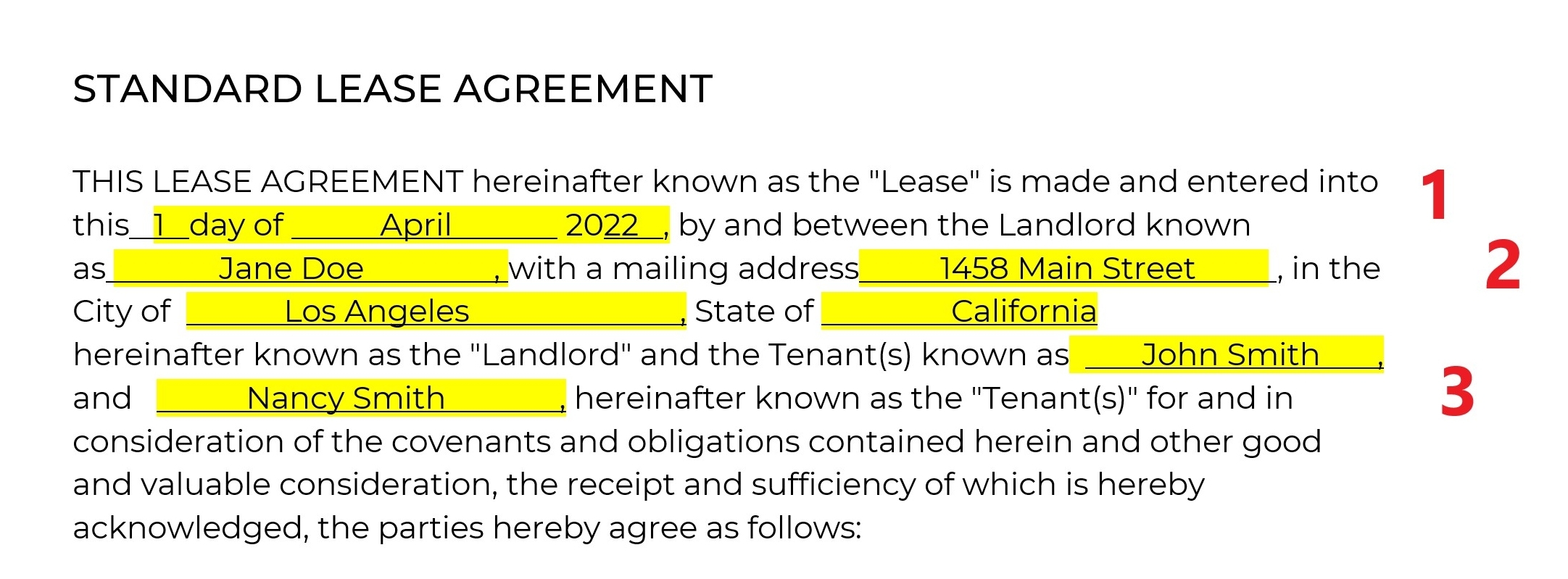
Section II. Location of the Premises
- Tenant’s Names – The full names of any and all tenants responsible for the lease.

Section III. Lease Term
- Lease Term – A clear statement of when the lease begins and ends.
- Termination Notice – Include the notice period required before terminating a month-to-month tenancy created after the lease ends.
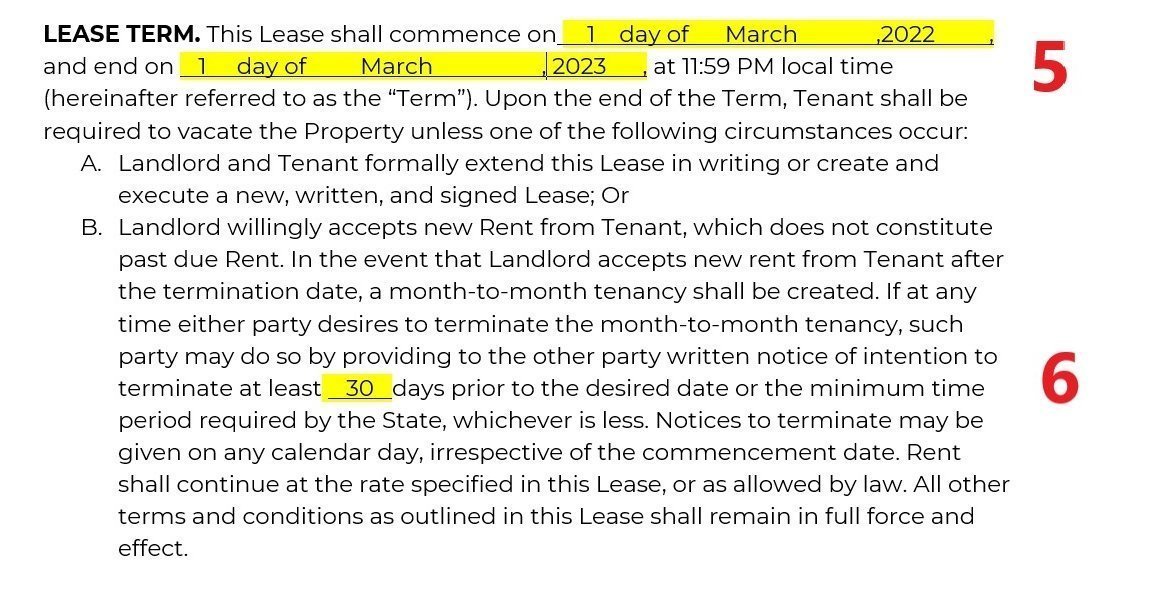
Section IV. Rent
- Monthly Rent Due – The price of rent due per month.
- When Rent is Due – The date rent is due (typically, the first day of each month).
- Late Fees and Grace Periods – Most states allow a late fee if rent is not paid on time. If there is a late fee, enter the fee details plus when rent is considered late.
- Returned Checks – A fee for a bounced check with non-sufficient funds (NSF). If there is a fee, enter the amount per bounced check. Note that many states set a maximum cap on returned check fees.
- Rent Increase – The effective date of any rent increase.
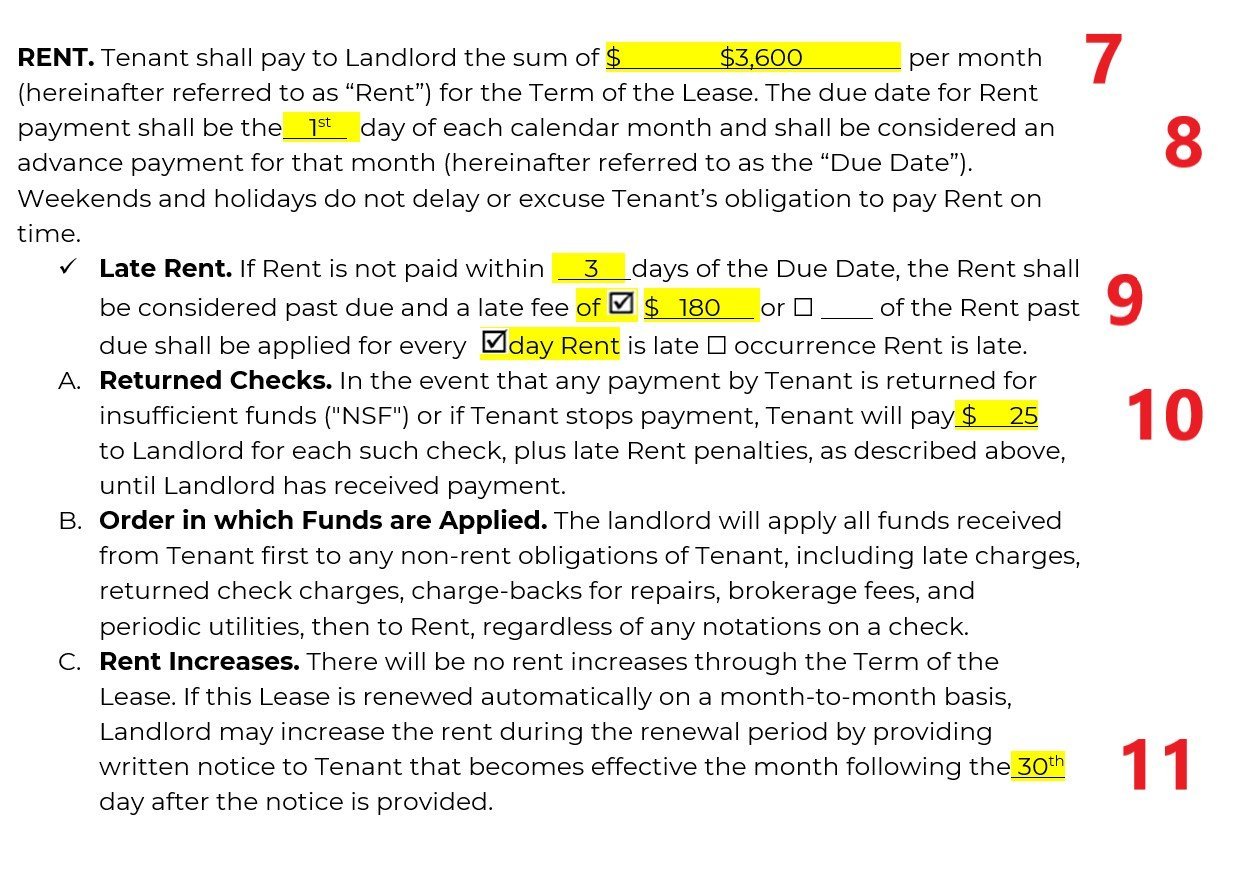
Section V. Security Deposit
- Security Deposit – Most leases collect a security deposit, generally equal to one month’s rent. Each state’s security deposit law indicates what a landlord can use the money for and the maximum allowed amount.
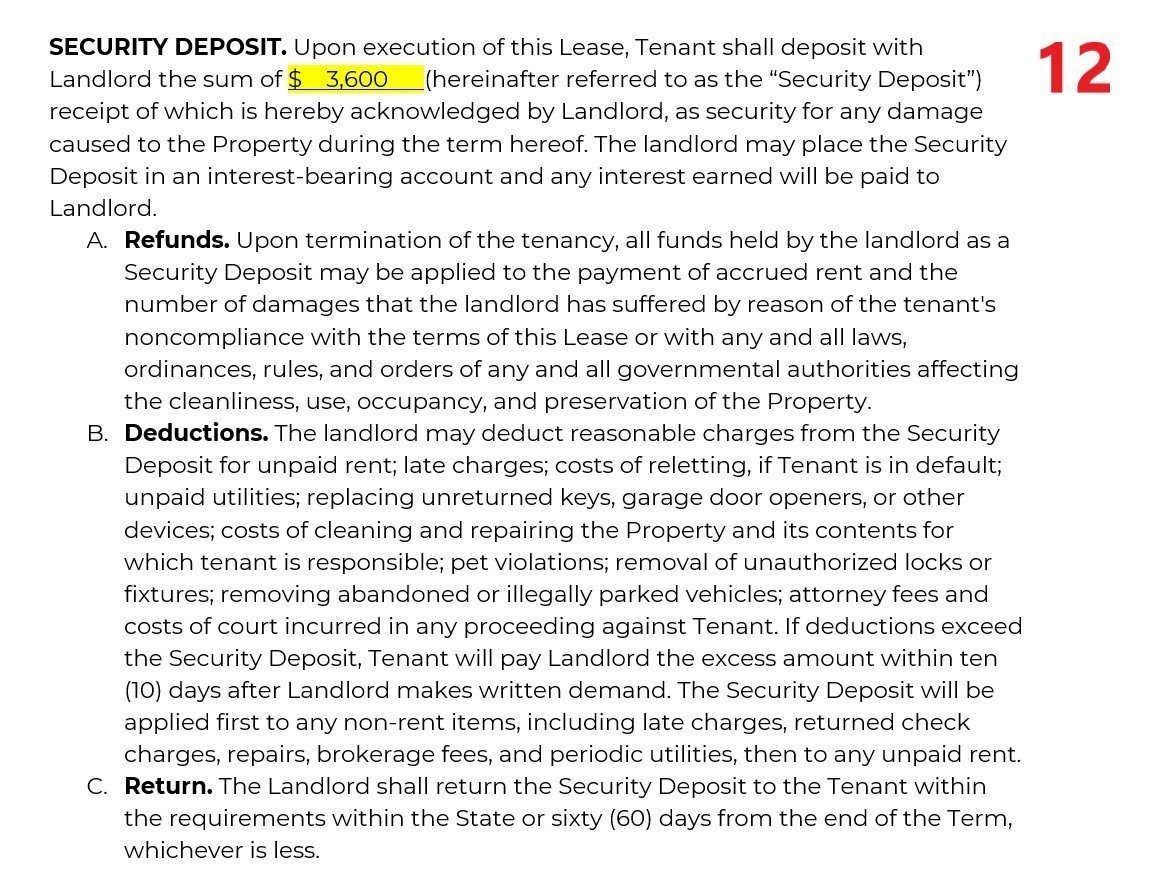
Section VI. Use of Property
- Occupants – All tenants who are allowed to occupy the property (not including temporary guest stays). This section lists anyone living on the rental property for an extended period, including children.
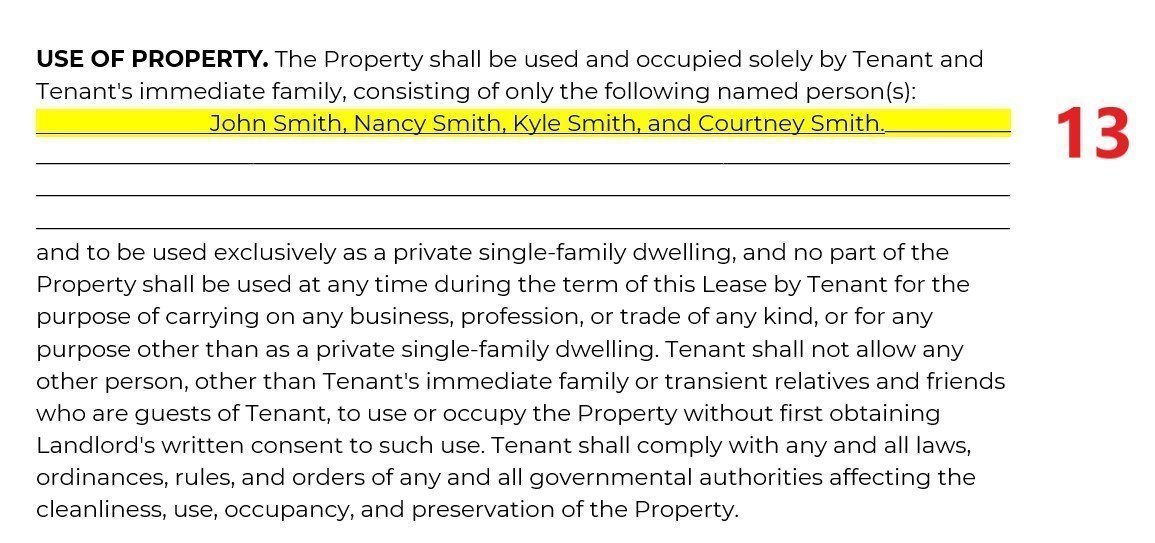
Section VII. Subletting
- Assignment – A check in the appropriate box allows or denies permission for the tenant to sublet the rental property. Note the specific amount of advance notice to which a landlord is entitled when getting details about an upcoming subtenant.
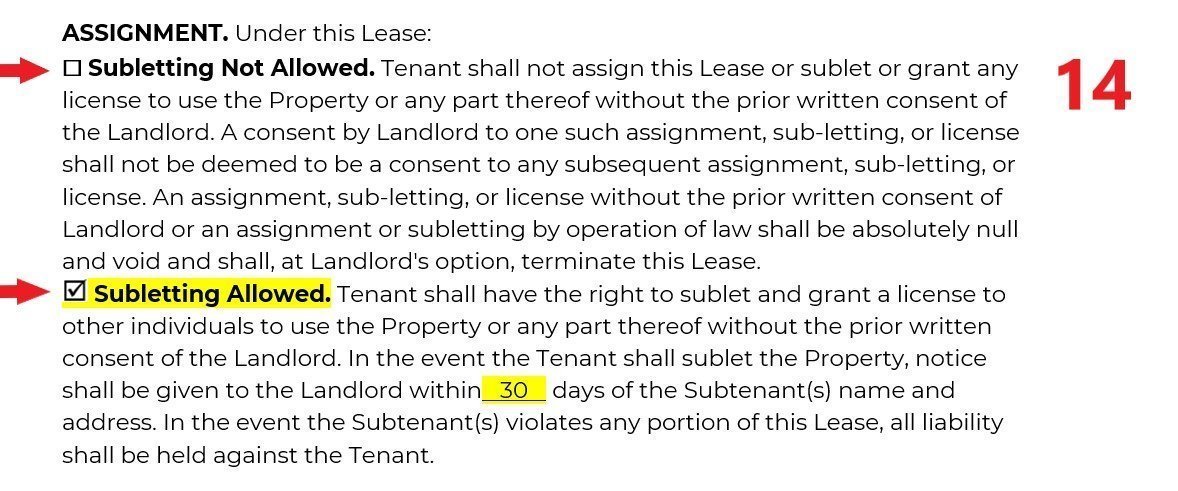
Section VIII. Right of Entry
- Landlord Access – While state laws regarding landlord access vary widely, in general landlords can enter rental property for relevant purposes during normal business hours. In most cases, they must provide advance notice before a non-emergency entry, typically 24 hours.

Section IX. Non-Delivery of Possession
- Non-Delivery of Possession – Provides a time limit within which the landlord must deliver initial possession of the rental property to the tenant. This protects the tenant’s rights in case there’s an issue like the previous tenant refusing to move out. This limitation on the start date of lease may be required under some state or local laws.

Section X. Utilities
- Utilities – Indicates which utilities and services the landlord will provide to the tenants. Any utility or service not mentioned in the lease is, by default, the tenant’s responsibility.

Section XI. Pets
- Pets – Indicates whether pets are allowed in the rental unit, and relevant restrictions on things like breed or weight. Any nonrefundable pet fees must be disclosed here. Landlords cannot charge any fees for lawful support and service animals, but can require proper documentation before admitting them to a rental property.
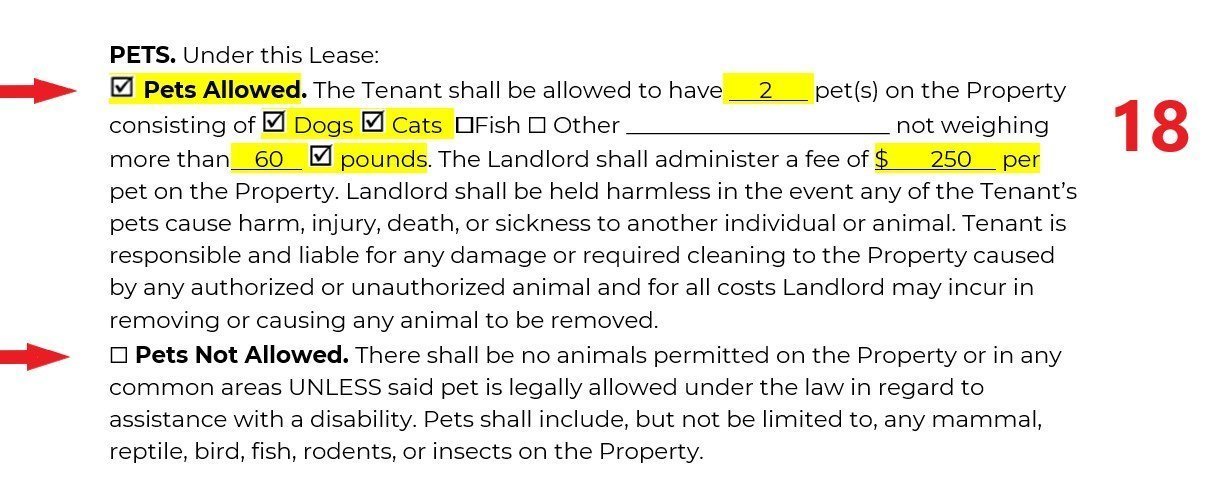
Section XII. Default
- Default – Provides terms for ending the lease, including the amount of advance notice before termination or a formal default on rent payment. Note that these notice periods may be fixed by state or local law.
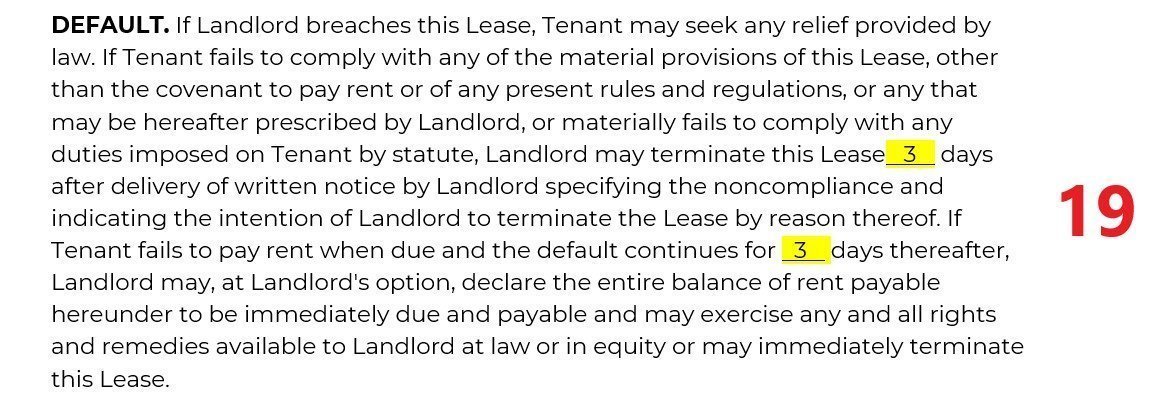
Section XIII. Notice
- Notice – Landlords must make themselves easy to contact for things like rent payment and repair requests. This field provides an address of record for streamlined contact between the landlord and tenant.

Section XIV. Parking
- Parking – Indicates whether the tenant receives a parking space as part of the lease as well as location and the terms on which the space is provided.

Section XV. Early Termination
- Early Termination – Indicates whether the tenant may break the lease early, as well as the notice and cost requirements. Some jurisdictions regulate the maximum early termination fee. Note that termination fees don’t apply if a tenant ends the lease due to landlord violations.

Section XVI. Smoking
- Smoking Policy – Describes the smoking policy for the rental property, including any designated smoking areas.

Section XVII. Signatures
- Signatures – The landlord and every adult tenant must sign the rental agreement to make it effective and binding on all parties. Each party customarily receives a copy of the lease upon execution. This is sometimes also a requirement under state law.
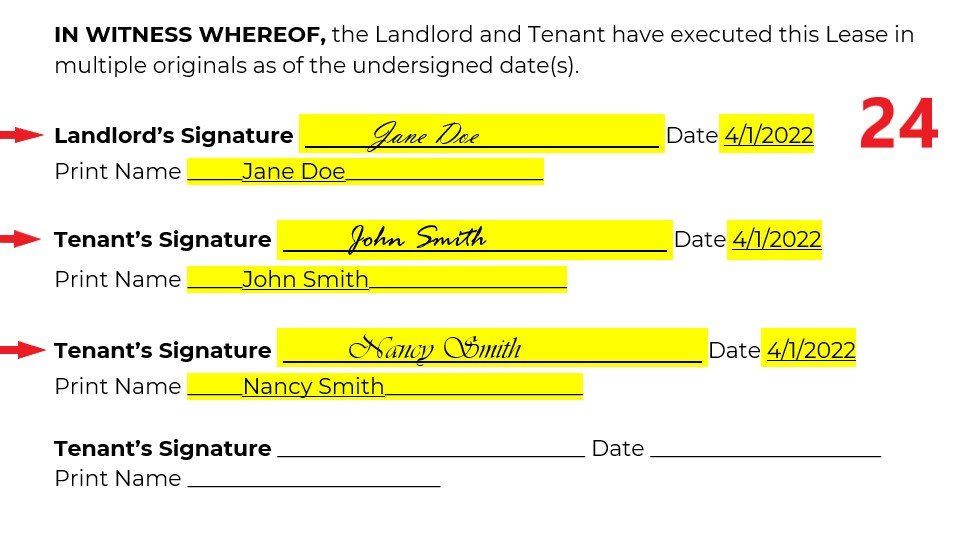
Frequently Asked Questions
Other rental templates.
Month-to-Month Rental Agreement
Rental Application Form
Residential Sublease Agreement
Lease Termination Letter
Room Rental Agreement
Commercial Lease Agreement
- Skip to primary navigation
- Skip to main content
- Skip to primary sidebar
- Skip to footer
Legal Templates
Home Real Estate Lease Agreement
Rental and Lease Agreement Templates
Use our Lease Agreement to rent out your residential property.
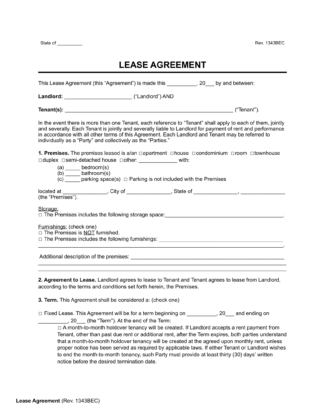
Updated May 15, 2024 Written by Jana Freer | Reviewed by Susan Chai, Esq.
A lease agreement (or rental agreement) is a document that explains the terms under which a tenant rents a residential or commercial property from a landlord.
Lease agreements are legally binding contracts that explain the obligations and rights of the tenant and landlord. Even if you’re renting out a room in your house to a friend or family member, you need a lease agreement for legal protection if you encounter problems with your tenants.
Lease Agreements – By State
- Connecticut
- District of Columbia
- Massachusetts
- Mississippi
- New Hampshire
- North Carolina
- North Dakota
- Pennsylvania
- Rhode Island
- South Carolina
- South Dakota
- West Virginia
- Lease Agreements - By State
- Lease Agreements - By Type
How to Lease a Property [Landlord Lifecycle]
- Landlord's Access
Security Deposit
Lease terms to know, how to write (fill out) a lease/rental agreement, sample lease agreement, frequently asked questions, lease agreements – by type, residential lease agreement forms [for landlords].
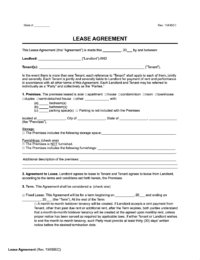
Use this template to rent out a residential property for a fixed period of typically one year.
This agreement includes the most essential and common clauses and can be used for a house, apartment, studio, condo, duplex, townhouse, basement, or mobile home.
Standard Lease Agreement
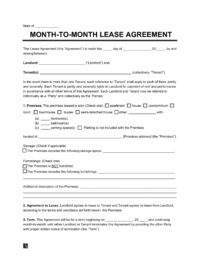
Use this template if you don’t want to commit to renting out your property for a full year or more, but still need to protect your rights. Using a monthly lease allows you (and your tenant) to be flexible.
Month-to-Month Lease Agreement
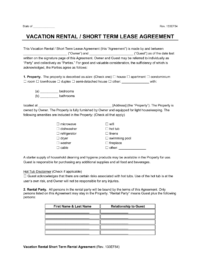
Use this template to rent out your property for a short period of time (usually between 1–31 days), most commonly as a vacation rental. A short-term rental agreement explains to guests the rules of their stay, and what they can expect when they arrive.
Short Term (Vacation) Rental
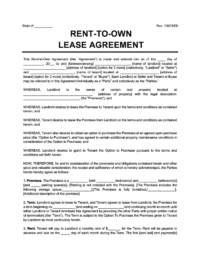
Rent-to-Own Lease Agreement
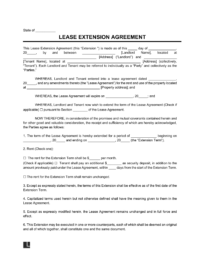
Lease Extension Agreement
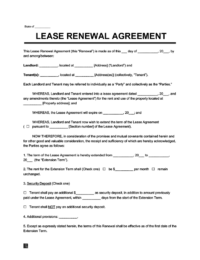

Lease Renewal Agreement
Sublease agreement forms [for tenants].
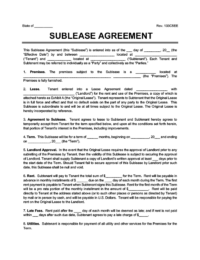
Use this template to rent out a property (or just a room) when you’re already renting the property from another landlord. For example, you may want to sublet a property if you need to move out but don’t want to break your lease.
Sublease Agreement
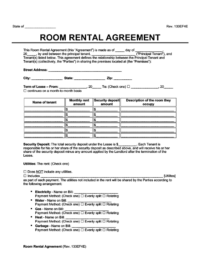
Use this template when you’re renting out a room in your property and need to set rules and boundaries. For example, you can use this agreement to explain how you'll divide rent and utility payments, and whether your tenant can have guests visit.
Room Rental Agreement
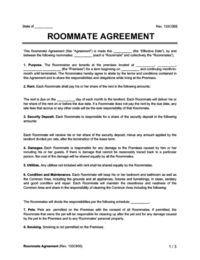
Roommate Agreement
Commercial lease agreement forms.
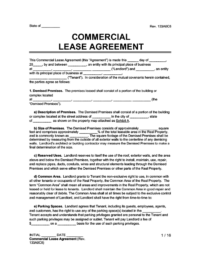
Use this template if you’re renting out an office building, retail space, restaurant, industrial facility, or any property where the tenant will operate a business.
Commercial Lease Agreement
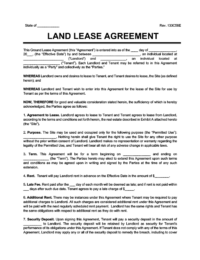
Use this template to rent out a piece of land that does not have a property on it. A land or ground lease can have multiple purposes, including agricultural, residential, and commercial.
Land Lease Agreement
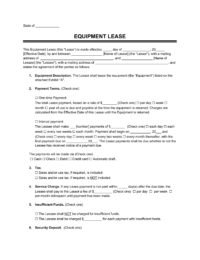
Equipment Lease Agreement
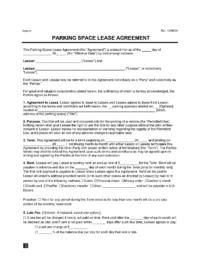
Parking Space Rental Agreement
Disclosures & addendums.
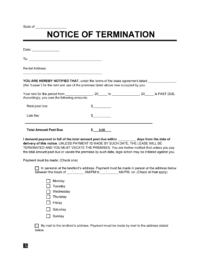
Commercial Lease Agreement Addendum
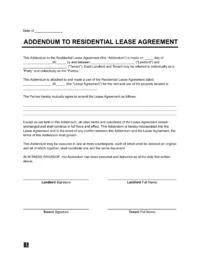
Residential Lease Agreement Amendment
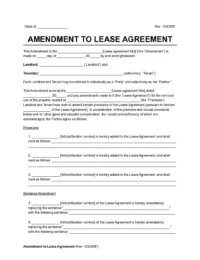
Lease Agreement Amendment
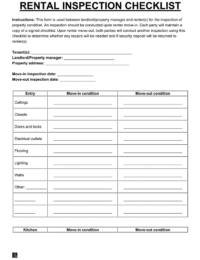
Rental Inspection Checklist

Rent Receipt
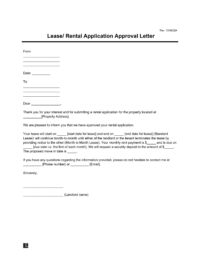
Tenant Approval Letter
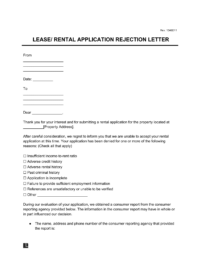
Tenant Rejection Letter
- Asbestos Disclosure ( Word ) – Notifty tenants of asbestos at the property (required for properties built before 1979).
- Bed Bug Addendum ( Word ) – Explain how both parties should act in case of a bedbug infestation.
- Carbon Monoxide and Smoke Detector Addendum ( Word )– State whether the landlord will provide carbon monoxide/smoke detectors and how the tenant is responsible for keeping them in good condition.
- Commercial Lease Addendum ( PDF ) – Modify an existing commercial lease or expand upon the current contract.
- Death in Rental Unit Disclosure ( Word ) – Inform the tenant if anyone previously died on the property.
- Disclosure of Lead-Based Hazard s ( PDF ) – Notify tenants of lead-based paint or other materials (required for properties built before 1978).
- Flood Hazard Area Disclosure ( Word ) – State whether the property is in a special flood hazard area.
- Foreclosure Notice ( Word ) – Inform the tenant of an impending foreclosure.
- Illegal Substance Contamination Disclosure ( Word ) – Notify the tenant if parts of the property have been contaminated due to manufacturing or storing an illicit substance (such as methamphetamine).
- Mold Disclosure ( Word ) – Notify the tenant that the property may contain mold and whether the landlord will fix it.
- Notice of Abandoned Personal Property ( Word ) – Tell the tenant they left something in the unit when they moved out and need to collect it before it’s thrown out.
- Pet Addendum ( PDF , Word ) – Let a tenant know the specific rules for having a pet on your property.
- Shared Utilities Disclosure ( Word ) – Explain how utilities are calculated and shared between multiple residents.
- Smoke-free Addendum ( PDF , Word ) – Specify whether your tenant can smoke marijuana or tobacco on your property.
Follow the steps below to rent your property easily:
Step 1 – Show Your Rental Unit to Tenants

The first step in renting out a house or an apartment is to allow people to view the property . If tenants like the property and want to move in, they will likely inquire about the rent amount and other details.
Hosting viewings can be inconvenient if you have multiple properties, so many landlords hire a property management company to show their rental units to potential tenants.
Step 2 – Give the Tenant a Rental Application Form to Fill Out
Once you agree on the rent price, the tenant should complete a rental application . This form helps the landlord screen the tenant, and it includes information such as the applicant’s:
- Current address
- Place of employment
- Income level
- Rental references
The tenant can confirm their workplace using an employment verification letter . This document is accessible for renters to show proof of income.
Typically, landlords require a small, non-refundable fee from the tenant to process the rental application.
Be aware of what you can and can’t ask on a rental application to abide by federal laws and prevent discrimination in the selection process.
Step 3 – Run a Background and Credit Check
After reviewing the tenant’s application, you should run a background check (and/or a credit check).
Running a credit check as part of the tenant-screening process can help avoid scams and problem tenants. The tenant usually pays for the cost of a credit check.
A background check shows if the applicant has a prior criminal history, and a credit check confirms whether the applicant has good or bad credit. Bad credit may signify poor financial planning, resulting in missed rent payments.
Although these checks help you avoid dealing with bad tenants, you shouldn’t base your decision to rent the property solely on the results.
Many states have strict guidelines on tenant discrimination. Refusing tenancy because of minor criminal offenses or bad credit may justifiably violate federal anti-discrimination law.
Step 4 – Check the Tenant’s References

Next, you must check the tenant’s references in their rental application form mentioned in step 2.
You should contact the references and ask questions such as:
- Did the applicant pay their rent and utilities on time?
- Were there any noise complaints at the tenant’s previous apartment?
- Have the police ever been called to the tenant’s last rental unit?
- Would you consider renting to this person again?
Rental references are usually from current or previous landlords and can give insight into the tenant’s character and behavior.
Step 5 – Create a Lease Agreement

Once you’re happy to rent your property to a tenant, you must create a lease/rental agreement in the correct format.
You make a lease agreement by writing it yourself from scratch, filling in a blank lease agreement template that includes all the necessary clauses, or using a lease agreement builder to create a lease specific to your property.
Remember to include the following:
- The move-in date
- The monthly rent payment amount
- When the rent is due each month
- How you’ll handle late rent payments
- Who should pay or manage the utilities
- The penalties, if any, for breaking a lease
Both parties sign the agreement after you create the lease contract and review all the details with the tenant. You may need to calculate prorated rent depending on when the tenant moves in.
Step 6 – Hand Over the Keys
Once the lease agreement is completed and signed, give the tenant the keys to move into the property.
Remember to conduct a unit walkthrough alongside the tenant to finish the process. Bring a rental inspection checklist and document the property’s condition before the tenant moves in.
Step 7 – Renew or Terminate the Lease
Allow the tenant to remain on the property until the lease termination date. If you thought your tenant was responsible and you want to renew their lease (and they also want to renew), use a lease renewal agreement to renew their tenancy.
If you don’t want to renew the lease, use a lease termination letter .
Landlord and Tenant Laws by State
Federal law recognizes that landlords and tenants have individual legal rights and obligations .
Find out what the law in your state says about your rights using the table below, or check the following specific laws for your property:
Landlord-Tenant Acts
Here are the general landlord-tenant acts by state:
Landlord’s Access
Tenants have the right to privacy when they rent a property. However, there may be reasons why a landlord needs to access the property , such as for maintenance or inspections.
Nearly every state requires a landlord to give advance notice to their tenants before accessing a rental unit. Use the table below to check how much notice you need to give in your state and review the relevant law:
Each state regulates the maximum amount of money a landlord can collect as a security deposit from a tenant. Some states also require landlords to return security deposits to tenants within a specific time (potentially with interest).
Usually, a landlord can deduct the following costs from the tenant’s security deposit:
- Unpaid rent
- Cleaning costs
- Key replacement costs
- Cost to repair damages above ordinary wear and tear
- Any other amount legally allowable under the lease
Use the table below to see the maximum security deposit limit in your state, whether it needs to be held in a separate account, and how much time you have to refund it after the lease ends:
Here are some helpful definitions for the legal language commonly present in lease and rental agreement forms:
- Access : The right to enter a property.
- Accidents : Artificial or naturally occurring events that may damage a property (fire, flood, earthquake, etc.).
- Alterations : Modifications made to a property.
- Appliances : Standard home equipment like a refrigerator or dishwasher.
- Assignment : The transfer of an interest in a lease.
- Attorney Fees : A payment made to a lawyer.
- Condemnation : The government is seizing private property for a public purpose, such as highway construction.
- Default : When a breach of contract occurs and persists, such as not paying rent or violating other terms of a rental agreement.
- Furniture : Standard home equipment such as couches, tables, beds, etc.
- Guarantor /Co-Signer : Someone accountable for paying rent if the tenant cannot.
- Guests : Short-term occupants of a rental property.
- Joint and several liabilities : Two or more people are independently held accountable for damages, regardless of who is at fault.
- Late Rent Fee : An additional, reasonable sum of money paid by a tenant after making a rent payment past the due date listed in the landlord-tenant agreement.
- Noise Policy : A provision outlining “quiet hours” in the apartment building, condominium, or neighborhood.
- Notice : A written announcement of some fact or observation.
- Option to Purchase : The tenant’s right to purchase the rental property later.
- Parking : Designated spaces where the tenant can keep their vehicles.
- Pet Policy : The permission or restriction of a tenant’s ability to have an animal in a rental property.
- Property Maintenance : Preserving a rental unit and who is responsible. Such as cutting the grass, removing the garbage, or unclogging the kitchen and bathroom drains.
- Renewal : A tenant’s option to continue the lease.
- Renter’s Insurance : A paid policy that protects personal belongings against theft or damage.
- Severability : A clause of a lease stating that if one part of the agreement is invalid for any reason, the rest of the lease is still enforceable.
- Smoking Polic y: The permission or restriction of a tenant’s smoking ability inside a rental property.
- Sublet : A temporary housing arrangement between current and new tenants to rent all or part of the currently leased property. The subletting period must be for less than the lease term.
- Successor : Someone who takes over the obligations of a lease from a tenant or landlord.
- Utilities : A public or private service supplying electricity, water, gas, or trash collection to a property.
- Waterbed : A water-filled furnishing used to sleep and not typically permitted in most rental properties.
Here’s how to write a lease :
Step 1 – Name the Parties
A simple rental agreement form must name the parties signing the lease and where they live. First, you should write down the following:
- The landlord or property management company and their current address

Step 2 – Describe the Premises
The “premises” are the exact address and type of rented property , such as an apartment, house, or condominium.

Step 3 – Define the Terms of the Lease
The “term” is the length of time a tenant will rent the listed property. A standard agreement should detail when the lease term begins and ends .
Furthermore, a lease can either be fixed-term or month-to-month.
- A fixed-term rental lease means the agreement is set for a predetermined or fixed period. This lease expires on the end date listed in the agreement (usually up to 6 months, one year, or two years from the start date).
- A month-to-month rental lease means the agreement lasts one month with no defined end date. It continues monthly until either the landlord or tenant terminates the agreement.

Step 4 – Set How Much Rent the Tenant Will Pay
A lease agreement must explicitly list the monthly rental amount and outline the consequences of late rent.
It’s up to the landlord to decide how much to charge for rent, but the cost is usually comparable to other properties within the same area.
In addition, standard rent control laws may limit the amount you can charge for rent. Check your local rent control ordinance to ensure your lease agreement complies with those regulations.

Step 5 – Assign a Security Deposit Amount
A security deposit is a set amount of money a landlord collects at the beginning of the lease.
Landlords have the right to collect a security deposit from their tenants. Still, their states’ security deposit laws define what landlords can use that money for (check the security deposit laws of your state ).
Step 6 – Finalize the Lease
Once you finish discussing the details with your tenant, remember to:
- Print – print at least two copies of the rental lease for you and the other party
- Sign – sign and date the lease agreement (both the tenant(s) and landlord)
- Save – safely file a hard copy of the signed document and consider scanning an electronic copy for extra safekeeping.
The following standard residential lease agreement works for all states except California , Florida , and Washington, DC .
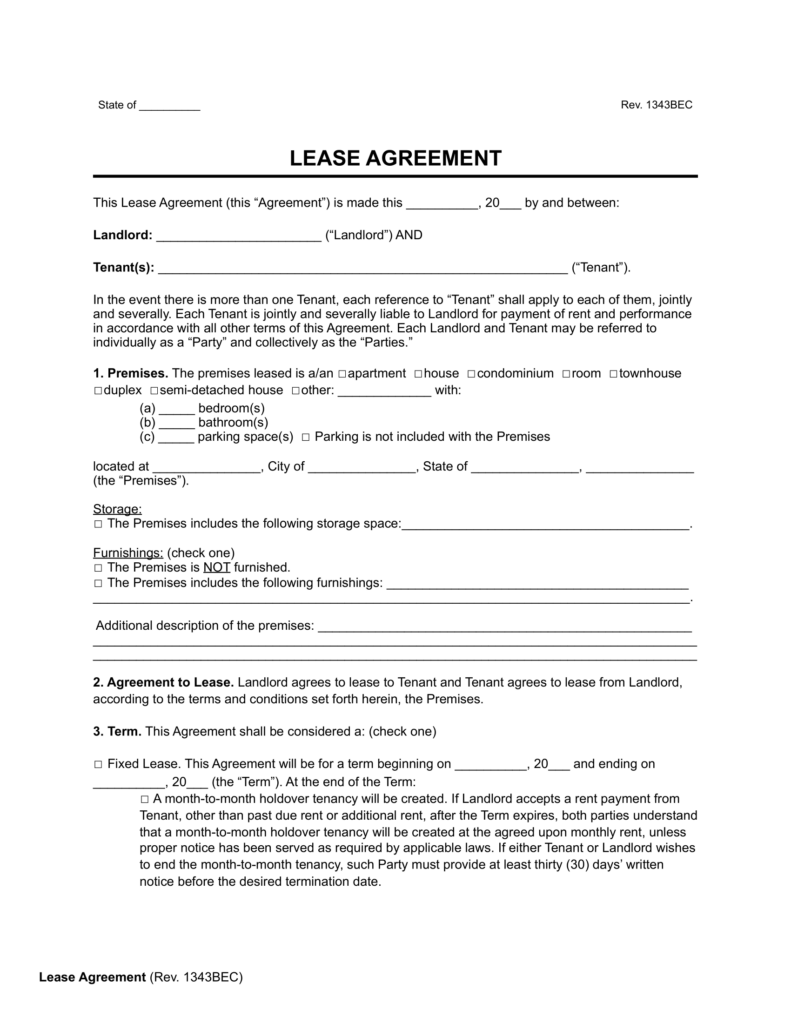
Why do I need a lease agreement?
]You need a lease agreement because it explains your responsibilities as a landlord and sets rules for the tenants living on your property. This form helps you avoid disputes with your tenants and address issues when they arise.
Suppose you rent out a property but don’t use a lease agreement. In that case, you could lose rent money, be liable for illegal activities on the property, receive penalties for unpaid utility costs, or spend a lot on property damage repairs and lawyer fees. Anyone renting a home, land, or commercial building should have a lease agreement.
How do I rent a room in my house?
You rent out a room in your house by using an agreement stating you’re renting out a room, not the entire property. If you’re a tenant living in a rental property, you can sublet a room to another tenant using a room rental agreement .
A standard residential lease and a room rental agreement allow you to establish quiet hours, the times guests can visit, the division of utility payments, and rules regarding pets, smoking, and parking.
Both parties sign the agreement to rent a room, and the landlord collects a security deposit from the tenant before handing over the keys.
What’s the difference between a lease and a rental agreement?
The difference between a lease and a rental agreement is the duration of the contract. Lease agreements are typically long-term (12 to 24 months), whereas rental agreements are usually short-term (a few weeks or months).
If you decide whether a lease or rent is best for you, remember that a lease agreement provides more security, but a rental agreement offers more flexibility.
What are my responsibilities as a landlord?
Your responsibilities as a landlord include the following:
- Repairing and maintaining the normal wear and tear of appliances like the air conditioner or heater.
- Respecting a tenant’s right to “quiet enjoyment” (living without disturbances). For example, you should deal with noise complaints accordingly, and you shouldn’t visit the property unnecessarily.
- Providing the tenant with a safe and clean home for the lease term. Examples include removing mold , resolving water damage, and fixing ventilation problems.
- Returning the tenant’s security deposit if the tenant treats the property respectfully and the rental is in good condition at the end of the lease term.
- Giving the tenant advance notice when you must enter the premises to fix something or show someone the property.
What happens if a tenant violates a lease?
If a tenant violates a lease , the landlord may try to resolve the problem by allowing the tenant to fix it (unless the violation is significant, such as using the property to sell or manufacture illegal drugs). If the issue is not resolved within a specific period (as set by state law), the landlord can begin eviction to remove the tenant.
Common lease violations include unpaid rent/utility bills and damage to the property.
What should I include in a lease agreement?
You should include the following information and clauses in a lease agreement:
- Names of all tenants : Write the names of every adult living on the property.
- Term : State the lease’s duration and whether it’s for a fixed period or will automatically renew.
- Rent : Set the amount of money the tenant will pay to live in the property and which day of the month the tenant will pay the rent.
- Premises : Describe the property and its location.
- Security deposit : Assign an amount of money the tenant will give the landlord to hold in case of any damages
Depending on your property and its location, you may need to include some standard disclosures and addendums that address specific situations, such as smoking or pets.
Related Documents
- Lease Termination Letter : A document created by the landlord or tenant in order to end an existing lease or rental agreement.
- Lease Renewal Agreement : Extends the term of an existing lease agreement between a landlord and a tenant.
- Eviction Notice : A written record that the Landlord properly notified the Tenant of a problem (i.e. lease violation, late rent, the lease ended).
- Legal Resources
- Partner With Us
- Terms of Use
- Privacy Policy
- Do Not Sell My Personal Information
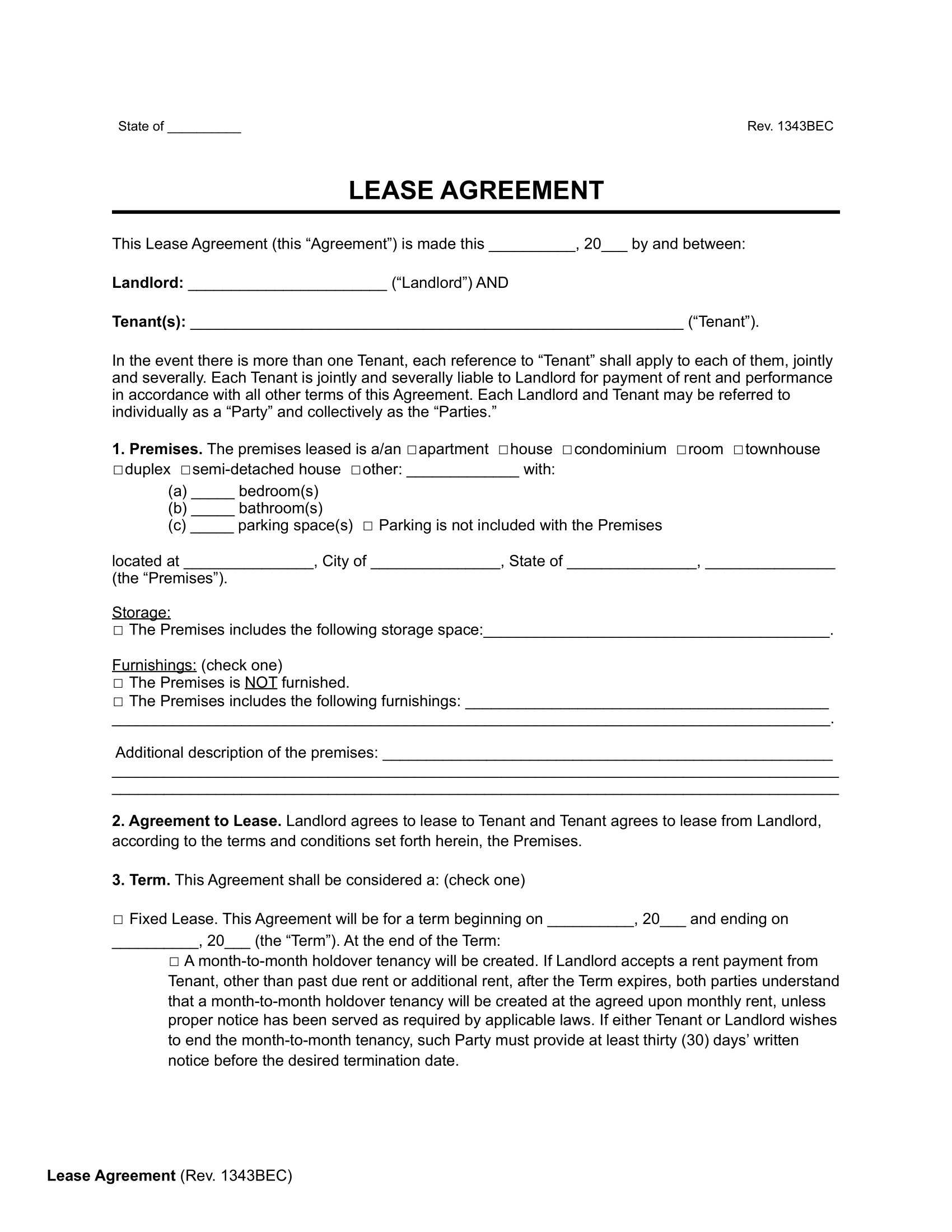
The document above is a sample. Please note that the language you see here may change depending on your answers to the document questionnaire.
Thank you for downloading!
How would you rate your free template?
Click on a star to rate

An official website of the United States government
Here's how you know
Official websites use .gov A .gov website belongs to an official government organization in the United States.
Secure .gov websites use HTTPS A lock ( Lock Locked padlock ) or https:// means you’ve safely connected to the .gov website. Share sensitive information only on official, secure websites.

The information and materials posted on this website are protected by copyright. The use and citation of materials is possible only with the indication of the authorship of the self-regulating organization of the association Russian Pellet Union and a reference to the source. Otherwise, the association reserves the right to file a claim for judicial protection of copyright with attribution to the infringer all legal costs.

IMAGES
VIDEO
COMMENTS
This residential lease assignment is between , an individual (the "Original Tenant") and an individual (the "New Tenant").. On or about , the Original Tenant and (the "Landlord") entered into a lease agreement (the "Lease").. The Lease covers the property located at , , , and more particularly described as follows: (the "Premises").. Under section of the Lease, the Original Tenant is permitted ...
Lease. 3. Assignment. The Assignor assigns, transfers and sets over unto the Assignee all of the Assignor's right, title and interest in and to the Lease, including, without limitation, any and all of the Assignor's right, title and interest in and to the Security Deposit referenced in Section
This is an agreement (the "Assignment") to assign a residential lease in real property according to the terms specified below. The Assignor wishes to assign and transfer to the Assignee that lease (the "Lease") dated May 26, 2024, ...
An assignment of lease from the seller to the buyer allows the new landlord to collect rent from any and all current tenants in the building. The language in the landlord's assignment of lease agreement can include assignment of security deposits, if the parties agree to it. An assignment of leases by the landlord to the buyer affords ...
Lease Assignment Agreement. Last revision 02/19/2024. Formats Word and PDF. Size 3 to 4 pages. 4.9 - 137 votes. Fill out the template. A Lease Assignment Agreement is a short document that allows for the transfer of interest in a residential or commercial lease from one tenant to another. In other words, a Lease Assignment Agreement is used ...
A lease assignment allows a tenant to "assign" and transfer the name of the lease, often the tenant, to someone else. The landlord must approve the tenant and, if accepted, an assignment will be executed by both parties. The assignee will be the new tenant and the original tenant will be released from the lease. Residential (Example)
The assignment of lease is a title document that transfers all rights possessed by a lessee or tenant to a property to another party. The assignee takes the assignor's place in the landlord-tenant relationship. You can view an example of a lease assignment here .
3. Assignment of Residential Lease (with Landlord Consent) Instructions The following provision-by-provision instructions will help you understand the terms of your assignment. The numbers below (e.g., Section 1, Section 2, etc.) correspond to provisions in the form. Please review the entire document before starting your step-by-step process.
A Lease Assignment is a legally binding agreement that allows a tenant to transfer their lease obligations to another tenant. Lease Assignments can be useful when the original tenant needs to move and wants someone else to take over the lease. A Lease Assignments can be used to transfer either a residential or commercial lease agreement, and ...
A Lease Assignment Agreement, also known as a lease transfer or an assignment of lease, can be used for both residential and commercial leases. A Lease Assignment Agreement: Allows the original tenant (the assignor) to transfer their remaining lease obligations to a new tenant (the assignee) Specifies the conditions of the assignment, such as ...
Lease assignment and subleasing a rental unit — whether residential or commercial — can both help you make some extra money from your unused rental property. But one is much more permanent than the other. Learn which option best suits your needs and situation by understanding the difference between subletting and assigning a lease.
A Residential Lease Agreement is a lease specific to residential rental properties that outlines the terms and conditions of a tenancy, including the landlord's and tenant's rights and obligations. ... Assignment and Subletting; Without the prior, express, and written consent of the Landlord, the Tenant will not assign this Lease, or sublet or ...
Lease Assignment Agreement: Templates & More. Transfers the assignor's rights and obligations to the assignee, with the landlord's consent, and should include negotiated clauses such as sharing of excess rents, assignment review fee, recapture rights, damages and indemnification.
With LawDepot's Consent to Lease Assignment template, tenants provide landlords with all of the necessary information to transfer their interest in a lease, including: Information about the original lease. The name of the new tenant (i.e. the assignee) The date the assignee takes over the lease.
To find the telephone number for your clinic call Legal Aid Ontario at (416) 979-1446 or 1-800-668-8258. You can also call the Tenant Hotline at 416- 921-9494 for free information and referrals to your local legal clinic. You can find information on line at www.acto.ca or www.cleo.on.ca. You can call the Landlord and Tenant Board toll free at ...
A residential lease lays out the basic rights and terms that the landlord and tenant agree will govern the occupation of the rental property. ... Assignment - A check in the appropriate box allows or denies permission for the tenant to sublet the rental property. Note the specific amount of advance notice to which a landlord is entitled when ...
A lease assignment, often called a lease takeover or a lease transfer, is the legal term for when your landlord allows you to pass responsibility for your apartment to another tenant. The new tenant, your assignee, becomes the tenant under the lease agreement instead of you. They pay the rent directly to the landlord and are treated as the ...
An assignment of leases is useful when someone would like the rental space or land that another is leasing and the current leaseholder cannot continue to support himself or herself on the property. The legal transfer of the lease permits the individual to give the rights of the agreement to the other person.
Residential Rental/Lease Agreement: A Residential Rental (Lease) Agreement is a contract between a landlord and tenant that is used to outline the terms of a residential tenancy. Landlord's Consent to Lease Assignment : A Landlord's Consent to Lease Assignment gives permission to the tenant to transfer all the rights the tenant had under the ...
A lease agreement (or rental agreement) is a document that explains the terms under which a tenant rents a residential or commercial property from a landlord.. Lease agreements are legally binding contracts that explain the obligations and rights of the tenant and landlord. Even if you're renting out a room in your house to a friend or family member, you need a lease agreement for legal ...
FHFA established the Suspended Counterparty Program to help address the risk to Fannie Mae, Freddie Mac, and the Federal Home Loan Banks ("the regulated entities") presented by individuals and entities with a history of fraud or other financial misconduct. Under this program, FHFA may issue orders suspending an individual or entity from ...
Residential (Land Lease) Communities Act 2013 No 97 [NSW] Current version for 31 May 2024 to date (accessed 7 June 2024 at 3:54) Page 54 of 109. event day, by the amount the Tribunal considers appropriate, (b) another order the Tribunal considers appropriate. Note— An example of an order under subsection (4)(b) is an order that the operator ...
Address: Maltseva St. 52, office 515A, Vologda, Vologda Oblast, 160000, Russia. The company is a manufacturer of wood pellets and briquettes, as well as the largest exporter of fuel pellets in the Vologda region. Production is carried out at two industrial sites. Produces pellets for household and industrial use.
The Bratsk Hydroelectric Power Station (also referred to as The 50 years of Great October Dam) is a concrete gravity dam on the Angara River and adjacent hydroelectric power station.It is the second level of the Angara River hydroelectric station cascade in Irkutsk Oblast, Russia.From its commissioning in 1966, the station was the world's single biggest power producer until Krasnoyarsk ...
25604000. Bratsky District ( Russian: Бра́тский райо́н) is an administrative district, one of the thirty-three in Irkutsk Oblast, Russia. [1] Municipally, it is incorporated as Bratsky Municipal District. [6] It is located in the northwest of the oblast. The area of the district is 33,660 square kilometers (13,000 sq mi). [3]
History. The first Europeans went to the area in 1623 to get taxes from the local Buryat people. Permanent settlement started with the building of an ostrog ().This fortress was built in 1631 at the junction of the Oka and Angara rivers.. During World War II, Siberia became more industrialized.This was because the Soviet Union wanted to move its industry to the area east of the Ural Mountains.
Residential Real Estate; San Antonio Inno ... which is subject to either sale or lease. Zachry "shall use best efforts to assist and facilitate the assignment and transition of any project data ...